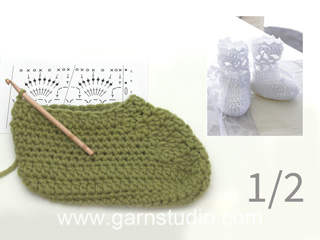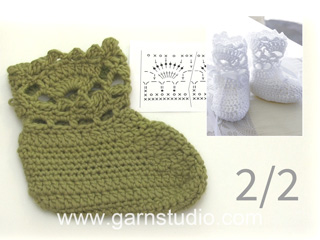So Charming Socks |
||||||||||||||||||||||||||||||||||
 |
 |
|||||||||||||||||||||||||||||||||
Crocheted baby slippers with fan edge for Christening or other special occasions in DROPS Safran.
DROPS Baby 29-4 |
||||||||||||||||||||||||||||||||||
|
CROCHET INFO: At the beginning of each round/row of single crochets, replace the first single crochet with 1 chain stitch. When working in the round, finish the round with 1 slip stitch in the chain stitch from the beginning of the round. When working back and forth, finish the row with 1 single crochet in the 3rd chain stitch from the beginning of row of double crochets. At the beginning of each round/row of double crochets, replace the first double crochet with 3 chain stitches. When working in the round, finish the round with 1 slip stitch in the 3rd chain stitch from the beginning of the round. When working back and forth, finish the row with 1 double crochet in the chain stitch from the beginning of the row of single crochets. INCREASE TIP: Increase 1 single crochet/double crochet by working 2 single crochets/double crochets in the same stitch. DECREASE TIP: Work 1 single crochet/double crochet, but wait with the last yarn over and pull through (= 2 loops on the hook), then work the next single crochet/double crochet, but when making the last pull through, pull the strand through all the loops on the hook - 1 single crochet/double crochet decreased. CROCHET TIP: On the round after the double crochets at the front of the slipper have been worked together 2 and 2, work a little tighter at the front of the slipper, i.e. the strand is tightened a little between each double crochet worked. This is done to prevent the mid piece at the front of the slipper being loose. PATTERN: See diagrams A.1. ---------------------------------------------------------- SLIPPER: READ CROCHET INFO and start with the sole – NOTE: Work in each stitch (not between stitches). REMEMBER THE CROCHET GAUGE! Work 19-21-23-25 chain stitches (including 1 chain stitch to turn) with hook size 3 mm / C and Safran. The first row is worked as follows: 1 single crochet in the 2nd chain stitch from the hook, 1 single crochet in each of the next 17-19-21-23 chain stitches = 18-20-22-24 single crochets, turn the piece. Continue by working 1 single crochet in each single crochet from the previous row AT THE SAME TIME as you increase 2 single crochets at the beginning and end of the first row by working 3 single crochets in the first and last single crochet on the row = 22-24-26-28 single crochets. Work single crochets back and forth until there is 1 row left before the piece measures 3-4-4-5 cm / 1"-1½"-1½"-2". Now decrease 2 single crochets in each side – READ DECREASE TIP = 18-20-22-24 single crochets on the row – NOTE: At the end of the row start decreasing when there are 4 single crochets left, then work the last 4 single crochets together 2 and 2. The piece measures approx. 3-4-4 (5) cm / 1"-1½"-1½" (2"). Cut and fasten the strand, the sole is now finished. Continue by working double crochets around the sole as follows: ROUND 1: Start mid back (= middle of the one short side) - Work 1 slip stitch in the first stitch, 3 chain stitches (= 1 double crochet), work 1-2-2-3 double crochets to the corner, 2 double crochets in the corner, 1 double crochet in each of the 18-20-22-24 single crochets along the side, 2 double crochets in the corner, 4-6-6-8 double crochets along the short side (= the toe), 2 double crochets in the corner, 18-20-22-24 double crochets along the side, 2 double crochets in the corner and 2-3-3-4 double crochets along the short side mid back, finish with 1 slip stitch in the 3rd chain stitch at the beginning of the round = 52-60-64-72 double crochets. NEXT ROUND IN SIZE 22/23 (this round is not worked in the other sizes): Work 1 round with 1 double crochet in each double crochet = 72 double crochets. NEXT ROUND IS WORKED AS FOLLOWS IN ALL SIZES: Work 1 double crochet in each double crochet, but decrease 1 double crochet in each of the 2 corners at the front of the toe – READ DECREASE TIP = 50-58-62-70 double crochets. CONTINUE BY WORKING AS FOLLOWS FROM MID BACK (work 1 stitch in each stitch from the previous round): ROUND 1: 19-22-24-27 single crochets, 1 half double crochet, work 2 double crochets together – READ DECREASE TIP, 6-8-8-10 double crochets, work 2 double crochets together, 1 half double crochet and 19-22-24-27 single crochets = 48-56-60-68 stitches. ROUND 2: 18-21-23-26 single crochets, 1 half double crochet, work 2 double crochets together, 6-8-8-10 double crochets, work 2 double crochets together, 1 half double crochet and 18-21-23-26 single crochets = 46-54-58-66 stitches. ROUND 3: 17-20-22-25 single crochets, 1 half double crochet, work 2 double crochets together, 6-8-8-10 double crochets, work 2 double crochets together, 1 half double crochet and 17-20-22-25 single crochets = 44-52-56-64 stitches. ROUND 4 IN SIZE 22/23 (this round is not worked in the other sizes): 24 single crochets, 1 half double crochet, work 2 double crochets together, 10 double crochets, work 2 double crochets together, 1 half double crochet and 24 single crochets = 62 stitches. THE NEXT ROUND IS WORKED AS FOLLOWS IN ALL SIZES: 16-19-21-23 single crochets, 1 half double crochet, work the next 10-12-12-14 double crochets together 2 and 2, 1 half double crochet and 16-19-21-23 single crochets = 39-46-50-55 stitches. THE NEXT ROUND IS WORKED AS FOLLOWS IN ALL SIZES: READ CROCHET TIP and work 14-17-19-21 single crochets, 1 half double crochet, work 2 double crochets together, 5-6-6-7 double crochets, work 2 double crochets together, 1 half double crochet and 14-17-19-21 single crochets = 37-44-48-53 stitches. THE NEXT ROUND IS WORKED AS FOLLOWS IN SIZE 22/23 (this round is not worked in the other sizes): 20 single crochets, 1 half double crochet, work 2 double crochets together, 7 double crochets, work 2 double crochets together, 1 half double crochet and 20 single crochets = 51 stitches. ALL SIZES: = 37-44-48-51 stitches. Work 1-1-2-2 rounds with 1 double crochet in each double crochet AT THE SAME TIME as the number of stitches is adjusted to 30-36-36-36 double crochets on the 1st round – READ INCREASE TIP/ DECREASE TIP – NOTE: If you wish the slipper to be bigger or smaller in the opening, the number of stitches can be adjusted to the desired measurements, but because of the pattern, the number of stitches needs to be divisible by 6. FAN PATTERN: ROUND 1: Work 1 single crochet in each double crochet = 30-36-36-36 single crochets. ROUND 2 (= row of holes for the silk ribbon): * 1 half double crochet in the first/next single crochet, 2 chain stitches, skip 2 single crochets *, repeat from *-* the rest of the round = 10-12-12-12 half double crochets with 2 chain stitches between each. ROUND 3: Work 1 single crochet in each double crochet and 3 single crochets around each chain-space, but in Size 15/17 only work 2 single crochets around the chain-space a total of 3 times on the round and in Sizes 18/19 + 20/21 + 22/23 work 4 single crochets around the chain-space a total of 1 time on the round) = 37-49-49-49 single crochets (the number of stitches is divisible by 12 + 1). Continue by working the fan pattern in the round as follows: work A.1A over the first stitch, then work 3-4-4-4 repeats of A.1B. When A.1 has been completed, cut and fasten the strand. Work another slipper in the same way. SILK RIBBON: Cut the silk ribbon into two equal lengths. Start mid front on the one slipper and thread the ribbon up and down through the row of holes. Tie a bow mid front. Do the same on the other slipper. |
||||||||||||||||||||||||||||||||||
Diagram explanations |
||||||||||||||||||||||||||||||||||
|
||||||||||||||||||||||||||||||||||

|
||||||||||||||||||||||||||||||||||
|
Have you made this or any other of our designs? Tag your pictures in social media with #dropsdesign so we can see them! Do you need help with this pattern?You'll find tutorial videos, a Comments/Questions area and more by visiting the pattern on garnstudio.com. © 1982-2024 DROPS Design A/S. We reserve all rights. This document, including all its sub-sections, has copyrights. Read more about what you can do with our patterns at the bottom of each pattern on our site. |
||||||||||||||||||||||||||||||||||


























































Comments / Questions (15)
Löste detta själv efter ett tag men då nästa fråga: följde både A1 o A2 3 ggr men det blev för många bågar med 8 stolpar. Ska man börja med bara 1 maska på A1 o sen enbart upprepa A2 3 ggr? Mvh/Susanne Bylund
05.02.2019 - 00:25Jag är på varv 3 på solfjädersmönstret och förstår inte där det står att det ska virkas 2 fm om luftmaskbågen i minsta storleken totalt 3 ggr på varvet. Vad innebär 3 ggr på varvet? Hjälp mig för nu har jag tyvärr kört fast! Mvh/Susanne Bylund
04.02.2019 - 20:50Ok, ich habe jetzt gemerkt, das hin und her gehäkelt wird. Aber ich denke die 3 cm Länge haben mich irritiert. Es ist vermutlich die Höhe gemeint.
28.05.2017 - 07:47In der Anleitung steht für die Sohle, man soll so lange weiterhäkeln, bis die Arbeit 3 cm misst. Nach der 1. Runde habe ich diese schon überschritten. Und man soll hin und her häkeln. Wird nicht in Runden gehäkelt?
28.05.2017 - 07:38DROPS Design answered:
Liebe Frau Vural, die Sohle ist in Reihen gehäkelt, dh nicht in der Runde. Viel Spaß beim häkeln!
29.05.2017 - 09:39Hvilken alder svarer fodlængderne til? Det er selvfølgelig afhængig af barnet - men ca? Er det til nyfødte eller? De er virkelig fine :-)
09.05.2017 - 12:05DROPS Design answered:
Hej Kirsten, ja de mindste er til nyfødte: Størrelse: 1/3 - 6/9 - 12/18 måneder (2) år
09.05.2017 - 15:04